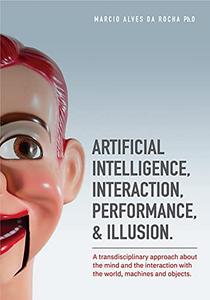
Artificial Intelligence, Interaction, Performance & Illusion: A transdisciplinary approach about the mind and the interaction with the world, machines and objects
By Marcio Alves da Rocha Ph.D
English | 2021 | ASIN : B094DQ8GGV | 181 pages | PDF, EPUB | 4 MB
The first thing that this book does is remind us that the strange and challenging idea of artificial intelligence has been with us for a very long time and that the way the term AI is used in the current marketing hype is almost entirely wrong. In the 21st century the term 'artificial' has somehow come to mean the 'same as' or as 'good as' (even better than) which, as Rocha points out, relies on a wonderful sleight of hand as one idea seamlessly becomes its anthesis. If this were just a talking point none of this would matter but it does. Indeed Alan Turing became so frustrated with the endless 'coffee housing' about the philosophical idea of artificial intelligence that he proposed the 'Turing Test' (which he readily admitted was a provisional convenience) just to get the debate heading in a practical direction. This imperative to get the debate moving is also the virtue of this thesis. Rocha's concern is to think about the ways in which human intelligence can be incorporated into HCI as an active and possibly quasi-autonomous agent. Like Turing, his approach is rooted in the material world of practice and he does well to remind us in some detail of attempts in the 18th century, (actually quite recent in the history of AI) to build machines that could do one or two of the clever things that humans can do. This was a time when inventions like clockwork movements, for example, were regarded as organisms, but now we have a different view of a hair-spring or escapement and see some of these 18th century automata as sophisticated frauds. This historical perspective, he argues, is important for how we think about AI today so that we might ask what frauds are we complicit in when we talk of machines that have human intelligence. Most radical of all, this calls for reflection on some of the scientific and constructed truths that form the explanations that are used to explain consciousness, the mind and human intelligence. He begins this root and branch challenge with short excursion into what is now regarded as media archaeology to reveal what was at stake in the 18th century craze for automata both for the creator (who usually gained prestige or made money from the trick) and, most importantly, for the viewer. Although engaging with these devices was, on the face of it, primarily an audiovisual experience for spectators, this historical journey recovers the crucial materiality and embodied dimensions of these inventions in a way that has resonance for us today. His argument is that while the body may be subject to historical change it remains a key datum for reflection on experiences and actions that arise from them. It is a lesson, he argues, that we might well learn (again) as we are caught up in design and engineering projects that have the illusion of immateriality. Without the coal, wind or water; plastic screens or chubby fingers there are no digits. His thesis reaffirms that the idea of artificial means acknowledging the trick of the ventriloquist or the concealed chess master inside Wolfgang von Kempelen's Automated Chess Player. And, most usefully, that we should factor this in to our design practices today as we build interfaces between humans and machines.
Buy Premium From My Links To Get Resumable Support,Max Speed & Support Me

https://rapidgator.net/file/1f6ac58a8cf55c3f4fefb21e738df608/xejdn.Artificial.Intelligence.Interaction.Performance..Illusion.rar.html

http://nitro.download/view/22872B963B68B2C/xejdn.Artificial.Intelligence.Interaction.Performance..Illusion.rar

https://uploadgig.com/file/download/4e6aa1A86b8df194/xejdn.Artificial.Intelligence.Interaction.Performance..Illusion.rar
